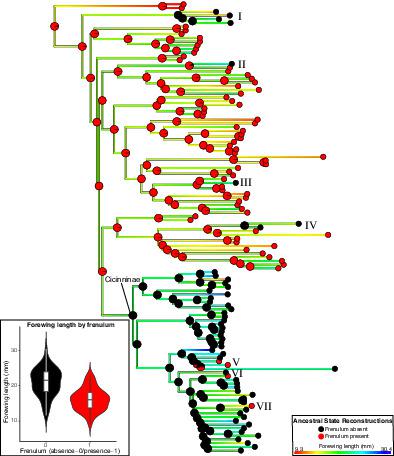当前位置:
X-MOL 学术
›
Syst. Entomol.
›
论文详情
Our official English website, www.x-mol.net, welcomes your feedback! (Note: you will need to create a separate account there.)
A new target capture phylogeny elucidates the systematics and evolution of wing coupling in sack‐bearer moths
Systematic Entomology ( IF 4.8 ) Pub Date : 2020-01-15 , DOI: 10.1111/syen.12421 Ryan A. St Laurent 1, 2 , Carlos G. C. Mielke 3 , Daniel Herbin 4 , Kelly M. Dexter 2 , Akito Y. Kawahara 1, 2, 5
Systematic Entomology ( IF 4.8 ) Pub Date : 2020-01-15 , DOI: 10.1111/syen.12421 Ryan A. St Laurent 1, 2 , Carlos G. C. Mielke 3 , Daniel Herbin 4 , Kelly M. Dexter 2 , Akito Y. Kawahara 1, 2, 5
Affiliation

|
The frenulum is a wing coupling structure that is found on the wings of most families of Lepidoptera. It is a single bristle or set of bristles that originate from the base of the hindwing that often interlocks with the forewing during flight. This wing coupling mechanism is thought to have been a major evolutionary innovation that allowed for enhanced flight in Lepidoptera. The sack‐bearer moths (Mimallonidae) are unusual among Lepidoptera in that not all species within the family have a frenulum. We test the hypothesis that the frenulum is not necessary and is therefore lost in mimallonids that have longer male forewings, because such wings are perhaps better suited to be coupled by other means. To understand the evolution of the frenulum, we inferred the most taxonomically and genetically sampled anchored hybrid enrichment‐based phylogeny of Mimallonidae, including 604 loci from all 41 genera and from 120 species, covering about 40% of the described species in the family. The maximum likelihood tree robustly supports major relationships within the family, and ancestral state reconstruction clearly recovers the frenulum as the plesiomorphic condition in Mimallonidae. Our results show that the frenulum is more often observed in species that have shorter, rather than longer, male forewings. The frenulum has historically been used as an important character for intrafamilial classification in Mimallonidae, but our results conclusively show that this character system is more variable than previously thought. Based on our results, we erect two new subfamilies, Roelofinae St Laurent & Kawahara, subfam.n. and Meneviinae St Laurent, Herbin, & Kawahara, subfam.n., for four genera previously considered incertae sedis. In the predominantly frenulum‐lacking clade Cicinninae, we describe a new genus, Cerradocinnus St Laurent, Mielke, & Kawahara, gen.n., and the genus Gonogramma stat. rev. is revalidated to include many species previously placed in Cicinnus sensu lato. With these changes, Cicinnus can now be considered monophyletic. Thirty‐three species are transferred to Gonogramma from Cicinnus sensu lato.
中文翻译:

一个新的目标捕获系统发育阐明了麻袋飞蛾翅膀耦合的系统学和进化
系带是一种翅膀耦合结构,在大多数鳞翅目家族的翅膀上都有发现。它是起源于后翅基部的单个或一组刚毛,在飞行过程中经常与前翅互锁。这种机翼耦合机制被认为是一项重大的进化创新,可以增强鳞翅目昆虫的飞行能力。袋鼠蛾(Mimallonidae)在鳞翅目中并不常见,因为并非该科中的所有物种都有系带。我们检验了以下假设:系带不是必需的,因此在雄性前翅较长的 mimallonids 中丢失了,因为这种翅膀可能更适合通过其他方式耦合。要了解系带的演变,我们推断出最多分类学和遗传学采样的基于锚定杂交富集的 Mimallonidae 系统发育,包括来自所有 41 个属和 120 个物种的 604 个基因座,覆盖了该科中约 40% 的描述物种。最大似然树强有力地支持家庭内的主要关系,祖先状态重建清楚地恢复了系带作为 Mimallonidae 的拟态条件。我们的结果表明,在雄性前翅较短而不是较长的物种中更常观察到系带。系带在历史上一直被用作 Mimallonidae 家族内分类的重要特征,但我们的结果最终表明,该特征系统比以前认为的更具可变性。根据我们的结果,我们建立了两个新的亚科,Roelofinae St Laurent 和 Kawahara, subfam.n. 和 Meneviinae St Laurent, Herbin, & Kawahara, subfam.n.,用于先前被认为是 incertae sedis 的四个属。在主要缺乏系带的进化枝 Cicinninae 中,我们描述了一个新属,Cerradocinnus St Laurent, Mielke, & Kawahara, gen.n. 和 Gonogramma stat 属。转 重新验证以包括以前放置在 Cicinnus sensu lato 中的许多物种。通过这些变化,Cicinnus 现在可以被认为是单系的。有 33 个物种从 Cicinnus sensu lato 转移到 Gonogramma。重新验证以包括以前放置在 Cicinnus sensu lato 中的许多物种。通过这些变化,Cicinnus 现在可以被认为是单系的。有 33 个物种从 Cicinnus sensu lato 转移到 Gonogramma。重新验证以包括以前放置在 Cicinnus sensu lato 中的许多物种。通过这些变化,Cicinnus 现在可以被认为是单系的。有 33 个物种从 Cicinnus sensu lato 转移到 Gonogramma。
更新日期:2020-01-15
中文翻译:

一个新的目标捕获系统发育阐明了麻袋飞蛾翅膀耦合的系统学和进化
系带是一种翅膀耦合结构,在大多数鳞翅目家族的翅膀上都有发现。它是起源于后翅基部的单个或一组刚毛,在飞行过程中经常与前翅互锁。这种机翼耦合机制被认为是一项重大的进化创新,可以增强鳞翅目昆虫的飞行能力。袋鼠蛾(Mimallonidae)在鳞翅目中并不常见,因为并非该科中的所有物种都有系带。我们检验了以下假设:系带不是必需的,因此在雄性前翅较长的 mimallonids 中丢失了,因为这种翅膀可能更适合通过其他方式耦合。要了解系带的演变,我们推断出最多分类学和遗传学采样的基于锚定杂交富集的 Mimallonidae 系统发育,包括来自所有 41 个属和 120 个物种的 604 个基因座,覆盖了该科中约 40% 的描述物种。最大似然树强有力地支持家庭内的主要关系,祖先状态重建清楚地恢复了系带作为 Mimallonidae 的拟态条件。我们的结果表明,在雄性前翅较短而不是较长的物种中更常观察到系带。系带在历史上一直被用作 Mimallonidae 家族内分类的重要特征,但我们的结果最终表明,该特征系统比以前认为的更具可变性。根据我们的结果,我们建立了两个新的亚科,Roelofinae St Laurent 和 Kawahara, subfam.n. 和 Meneviinae St Laurent, Herbin, & Kawahara, subfam.n.,用于先前被认为是 incertae sedis 的四个属。在主要缺乏系带的进化枝 Cicinninae 中,我们描述了一个新属,Cerradocinnus St Laurent, Mielke, & Kawahara, gen.n. 和 Gonogramma stat 属。转 重新验证以包括以前放置在 Cicinnus sensu lato 中的许多物种。通过这些变化,Cicinnus 现在可以被认为是单系的。有 33 个物种从 Cicinnus sensu lato 转移到 Gonogramma。重新验证以包括以前放置在 Cicinnus sensu lato 中的许多物种。通过这些变化,Cicinnus 现在可以被认为是单系的。有 33 个物种从 Cicinnus sensu lato 转移到 Gonogramma。重新验证以包括以前放置在 Cicinnus sensu lato 中的许多物种。通过这些变化,Cicinnus 现在可以被认为是单系的。有 33 个物种从 Cicinnus sensu lato 转移到 Gonogramma。


























 京公网安备 11010802027423号
京公网安备 11010802027423号